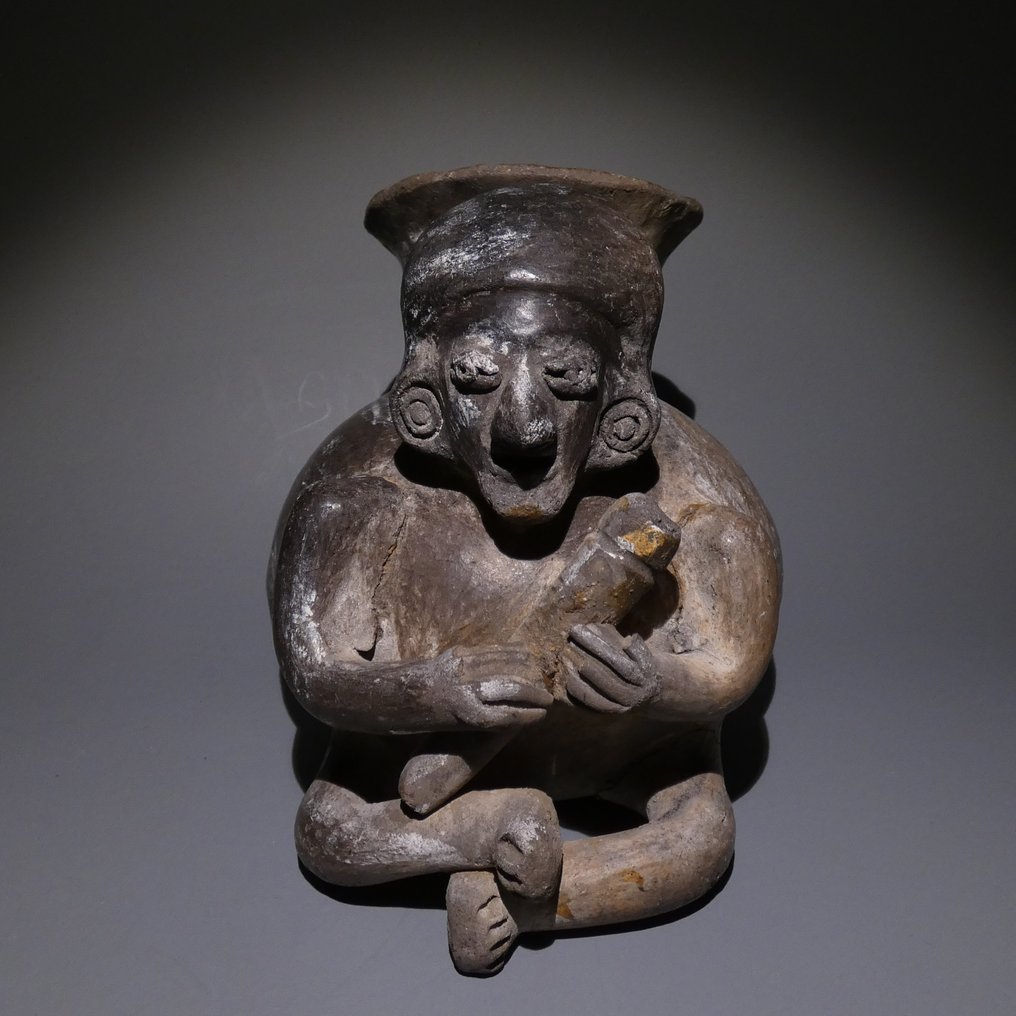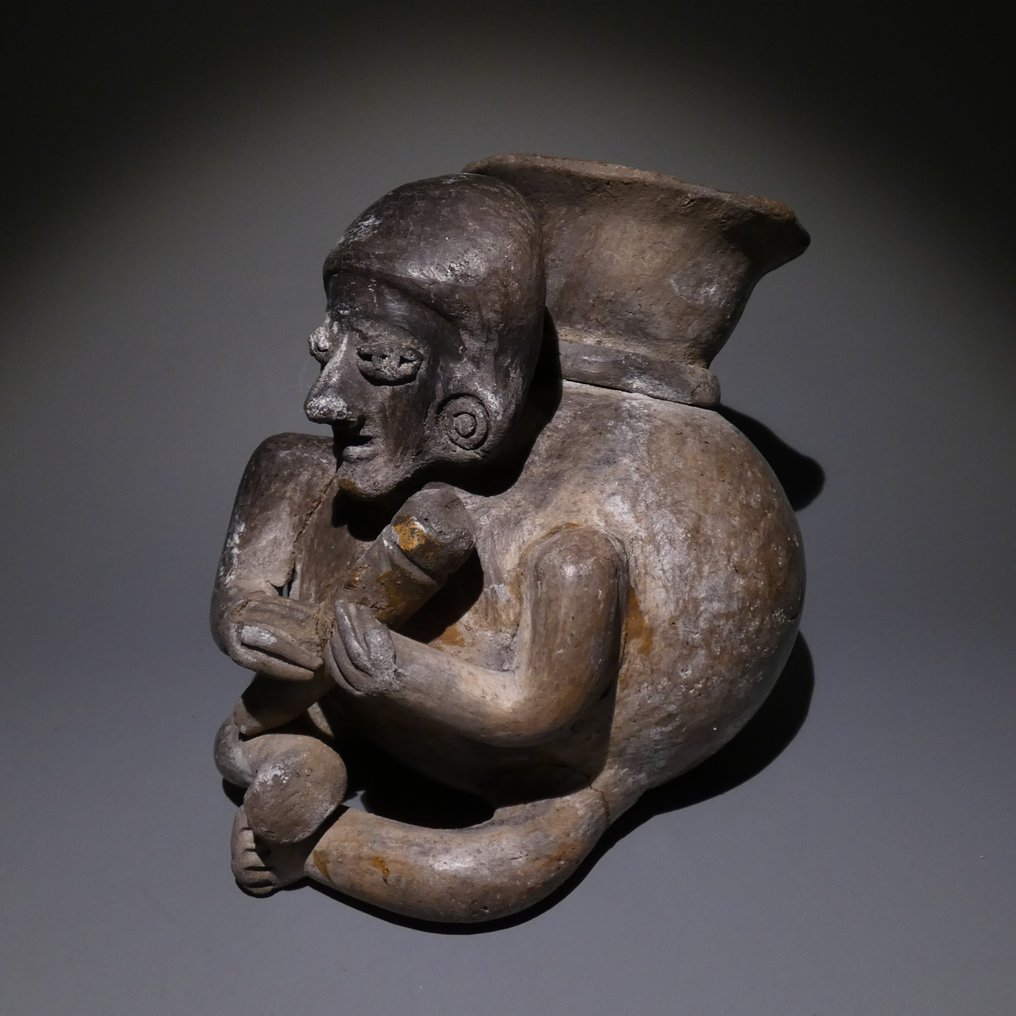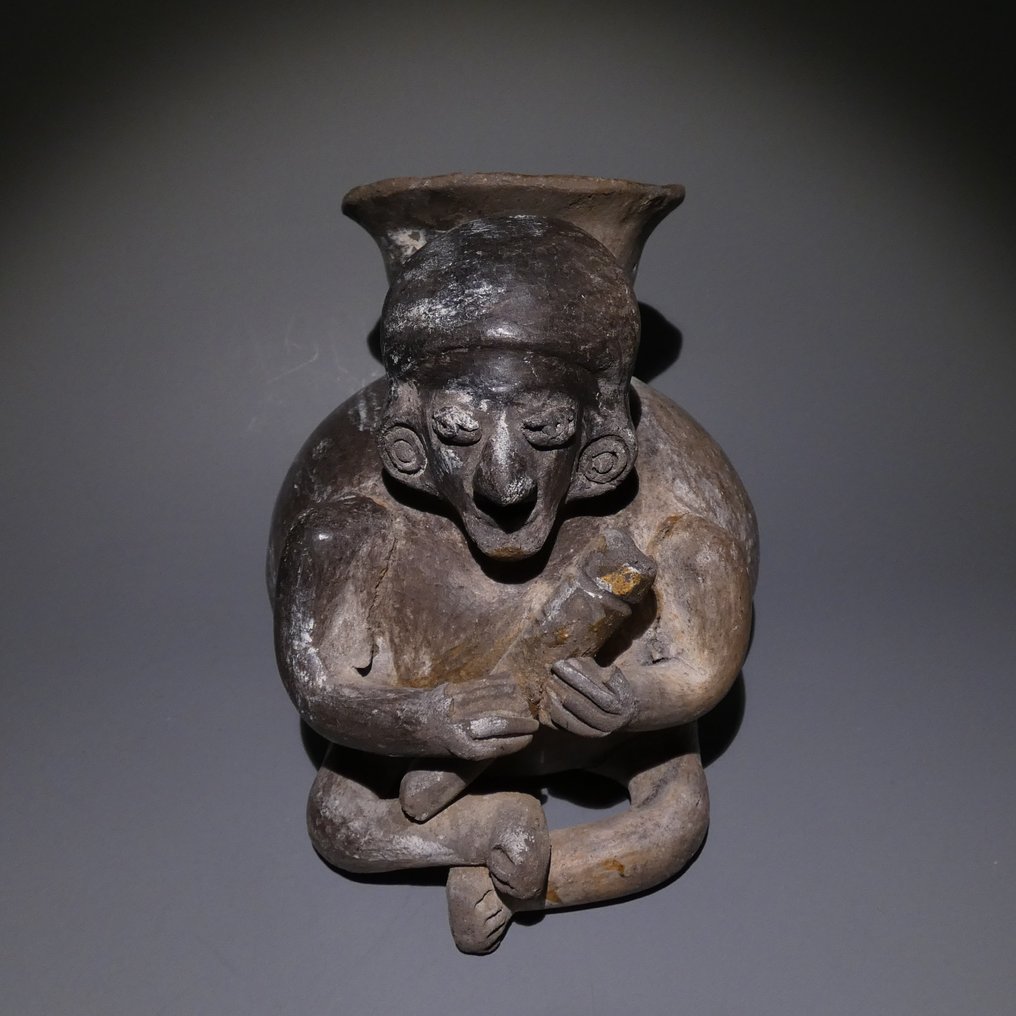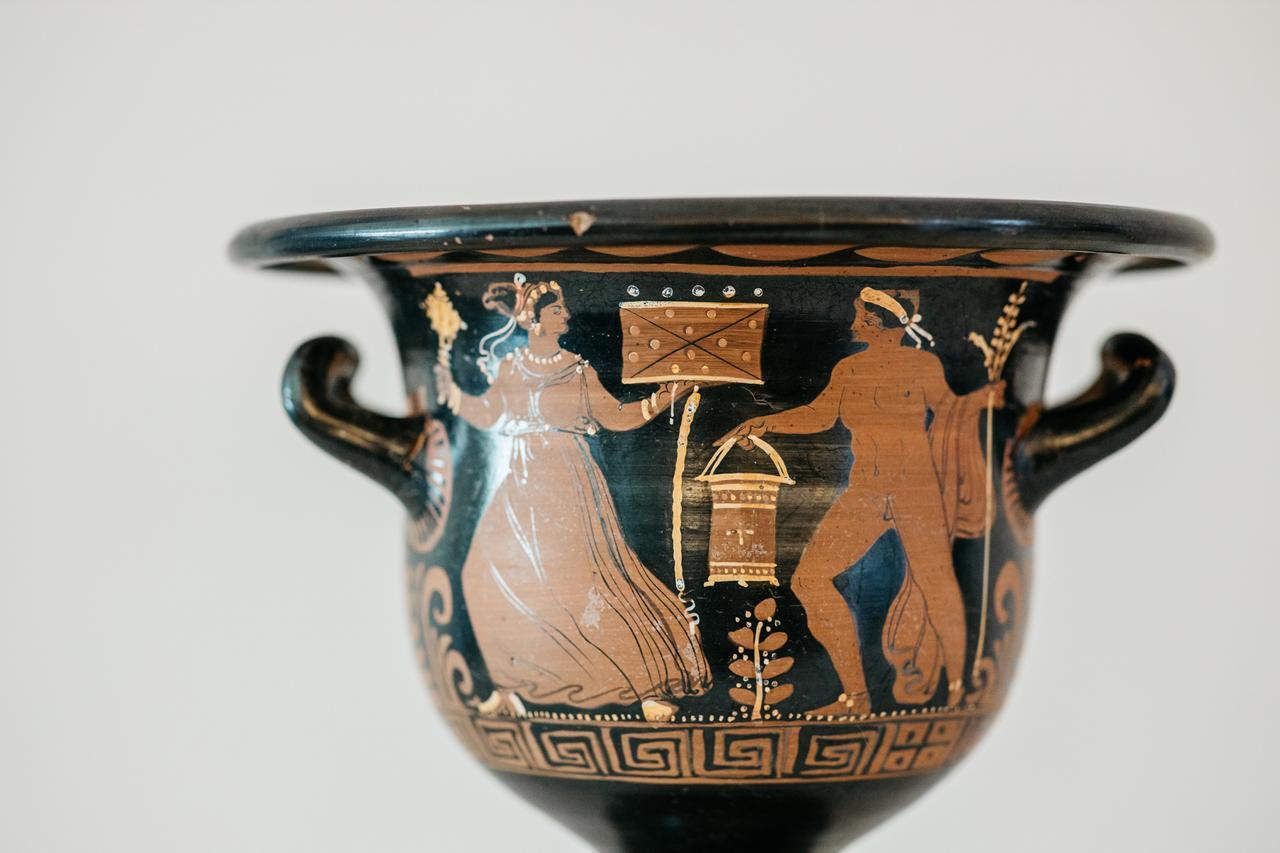Colima, Messico, Terracotta Vaso figurativo. Altezza 13 cm. 100 a.C. - 250 d.C. Licenza di esportazione spagnola.






Ha diretto il museo della collezione Ifergan, specializzata in archeologia fenicia.
Tutela degli acquirenti Catawiki
Il tuo pagamento è al sicuro con noi finché non ricevi il tuo oggetto.Mostra dettagli
Trustpilot 4.4 | 122473 recensioni
Valutato Eccellente su Trustpilot.
Vaso figurativo Colima dal Messico, datato 100 a.C.–250 d.C., realizzato in terracotta, circa 13 cm di altezza e 14 cm di diametro, Provenienza: collezione privata a Barcellona (J. R., 1928–2013), con certificato di autenticità e licenza di esportazione spagnola, in buone condizioni.
Descrizione del venditore
Vaso figurativo
Colima, Messico, 100 a.C. - 250 d.C.
Terracotta
13 cm di altezza e 14 cm di diametro
Provenienza:
- Collezione privata, J. R. (1928 - 2013) Barcellona, costituita dal 1950 fino al 2000. Da allora, per discendenza.
DOCUMENTI:
Licenza di esportazione spagnola
Buone condizioni, vedi foto.
Il popolo di Colima viveva nel nord-ovest del Messico, in una regione costiera accidentata e a bassa quota scolpita da valli, ognuna con la propria ecologia e un clima caldo e umido.
La ceramica di Colima presenta una vasta gamma di figure e forme, ma poca variazione nella tecnica. La maggior parte dei pezzi ha una finitura rossa levigata e alcuni sono decorati con incisioni arancioni o bianche. Le figure modellate sono comuni, soprattutto di piante, animali (soprattutto cani) e conchiglie. Le rappresentazioni umane mostrano tipicamente nani e gobbi più che altri, e poche forme femminili. Molte di queste figure hanno occhi a fagiolo e sono vestite con abiti tradizionali finemente dettagliati. Poco si conosce della lavorazione della pietra di Colima; sono stati trovati solo alcuni pezzi come teste di mazze, piccole maschere e figurine. Questi popoli praticavano anche la tessitura di cesti e tessuti, e usavano la metallurgia per realizzare oggetti come aghi, asce, sonagli, anelli nasali e ornamenti per orecchie.
La stragrande maggioranza dei pezzi in ceramica attribuiti a questa cultura sono oggetti funerari trovati nelle tombe di individui di alto rango sociale. I Colima seppellivano i loro morti in tombe di famiglia fino a 30 metri di profondità, alcune con più camere. I corpi erano accompagnati da una vasta gamma di oggetti funerari, tra cui statuette in ceramica di uomini armati, che fungevano da guardiani simbolici. Le sculture in ceramica di cani erano un altro oggetto funerario comune, e si credeva fossero gli emissari di Xolotl, il dio della morte.
Note:
Il pezzo include il certificato di autenticità.
- Il pezzo include la licenza di esportazione spagnola (passaporto per l'Unione Europea). NON TASSE.
Secondo la legislazione spagnola, gli articoli inviati al di fuori dell'Unione Europea sono soggetti a tasse di esportazione e verranno aggiunti alla fattura, a carico dell'acquirente. Queste tasse di esportazione sono calcolate sul prezzo finale d'asta e l'aliquota fiscale non viene applicata direttamente sul valore totale dell'articolo da esportare, ma vengono applicate diverse percentuali a sezioni su di esso:
- Fino a 6.000 euro: 5%.
- Da 6.001 a 60.000 euro: 10%.
Questo processo di richiesta di permesso di esportazione può richiedere al massimo tra 1 e 2 mesi.
Il venditore garantisce di aver acquisito questo pezzo in conformità con tutte le leggi nazionali e internazionali relative alla proprietà dei beni culturali. Dichiarazione di provenienza vista da Catawiki.
Il venditore si racconta
Vaso figurativo
Colima, Messico, 100 a.C. - 250 d.C.
Terracotta
13 cm di altezza e 14 cm di diametro
Provenienza:
- Collezione privata, J. R. (1928 - 2013) Barcellona, costituita dal 1950 fino al 2000. Da allora, per discendenza.
DOCUMENTI:
Licenza di esportazione spagnola
Buone condizioni, vedi foto.
Il popolo di Colima viveva nel nord-ovest del Messico, in una regione costiera accidentata e a bassa quota scolpita da valli, ognuna con la propria ecologia e un clima caldo e umido.
La ceramica di Colima presenta una vasta gamma di figure e forme, ma poca variazione nella tecnica. La maggior parte dei pezzi ha una finitura rossa levigata e alcuni sono decorati con incisioni arancioni o bianche. Le figure modellate sono comuni, soprattutto di piante, animali (soprattutto cani) e conchiglie. Le rappresentazioni umane mostrano tipicamente nani e gobbi più che altri, e poche forme femminili. Molte di queste figure hanno occhi a fagiolo e sono vestite con abiti tradizionali finemente dettagliati. Poco si conosce della lavorazione della pietra di Colima; sono stati trovati solo alcuni pezzi come teste di mazze, piccole maschere e figurine. Questi popoli praticavano anche la tessitura di cesti e tessuti, e usavano la metallurgia per realizzare oggetti come aghi, asce, sonagli, anelli nasali e ornamenti per orecchie.
La stragrande maggioranza dei pezzi in ceramica attribuiti a questa cultura sono oggetti funerari trovati nelle tombe di individui di alto rango sociale. I Colima seppellivano i loro morti in tombe di famiglia fino a 30 metri di profondità, alcune con più camere. I corpi erano accompagnati da una vasta gamma di oggetti funerari, tra cui statuette in ceramica di uomini armati, che fungevano da guardiani simbolici. Le sculture in ceramica di cani erano un altro oggetto funerario comune, e si credeva fossero gli emissari di Xolotl, il dio della morte.
Note:
Il pezzo include il certificato di autenticità.
- Il pezzo include la licenza di esportazione spagnola (passaporto per l'Unione Europea). NON TASSE.
Secondo la legislazione spagnola, gli articoli inviati al di fuori dell'Unione Europea sono soggetti a tasse di esportazione e verranno aggiunti alla fattura, a carico dell'acquirente. Queste tasse di esportazione sono calcolate sul prezzo finale d'asta e l'aliquota fiscale non viene applicata direttamente sul valore totale dell'articolo da esportare, ma vengono applicate diverse percentuali a sezioni su di esso:
- Fino a 6.000 euro: 5%.
- Da 6.001 a 60.000 euro: 10%.
Questo processo di richiesta di permesso di esportazione può richiedere al massimo tra 1 e 2 mesi.
Il venditore garantisce di aver acquisito questo pezzo in conformità con tutte le leggi nazionali e internazionali relative alla proprietà dei beni culturali. Dichiarazione di provenienza vista da Catawiki.
Il venditore si racconta
Dettagli
Disclaimer
Il venditore è stato informato da Catawiki dei requisiti di documentazione e garantisce quanto segue: - l’oggetto è stato ottenuto legalmente - il venditore ha diritto a vendere e/o esportare l’oggetto, se del caso - il venditore fornirà le informazioni di provenienza necessarie e predisporrà documentazione e licenze/permessi richiesti, se del caso e in base alle leggi locali - il venditore comunicherà all’acquirente eventuali ritardi nell’ottenimento di permessi/licenze Facendo offerte, dichiari di essere a conoscenza della possibilità che siano richiesti documenti d’importazione in base al tuo Paese di residenza e che l’ottenimento di permessi/licenze potrebbe causare ritardi nella consegna del tuo oggetto.
Il venditore è stato informato da Catawiki dei requisiti di documentazione e garantisce quanto segue: - l’oggetto è stato ottenuto legalmente - il venditore ha diritto a vendere e/o esportare l’oggetto, se del caso - il venditore fornirà le informazioni di provenienza necessarie e predisporrà documentazione e licenze/permessi richiesti, se del caso e in base alle leggi locali - il venditore comunicherà all’acquirente eventuali ritardi nell’ottenimento di permessi/licenze Facendo offerte, dichiari di essere a conoscenza della possibilità che siano richiesti documenti d’importazione in base al tuo Paese di residenza e che l’ottenimento di permessi/licenze potrebbe causare ritardi nella consegna del tuo oggetto.
